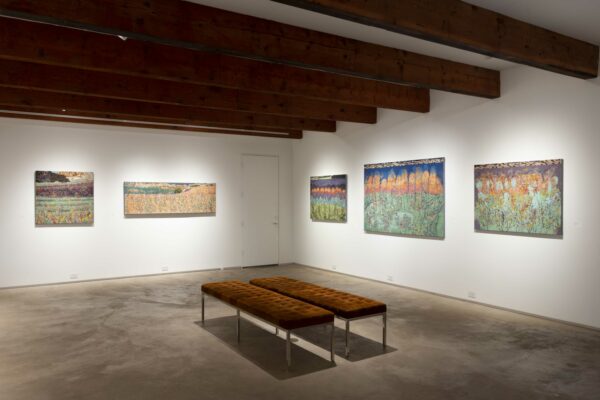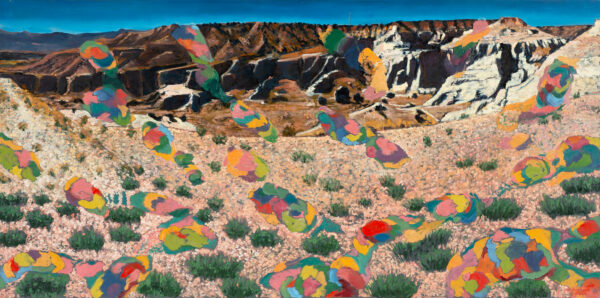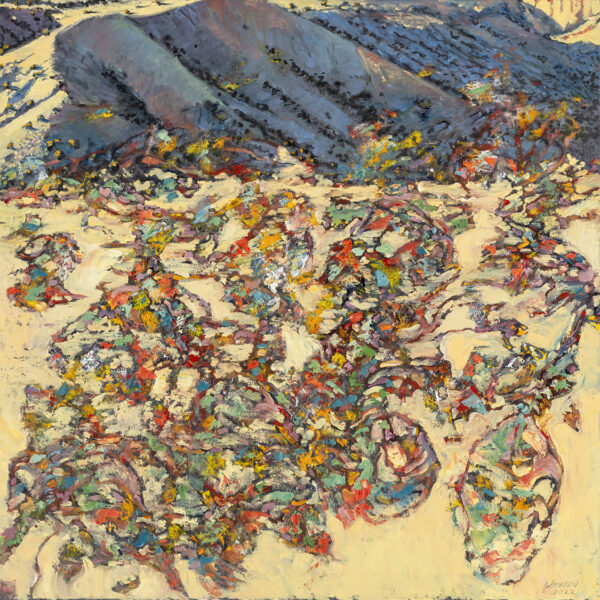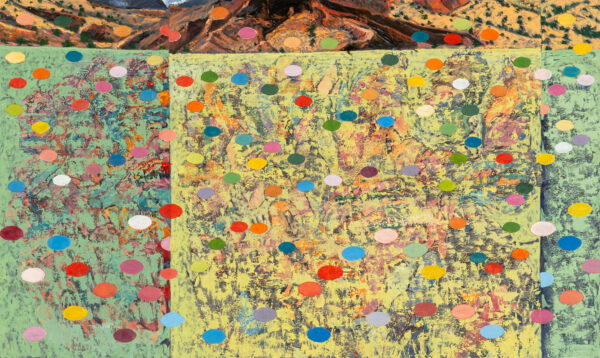
Installation view of “Jim Woodson: Mediated Time,” 2024, on view at Valley House Gallery through February 10, 2024.
Jim Woodson has long painted deliciously observed landscapes in his work without being confined to the role of “Landscape Painter.” Mediated Time, his fifth solo exhibition at Valley House Gallery, does not deviate from this. Woodson is a known entity in the Texas art community, being named Texas State 2D Artist in 2013 by the Texas Commission on the Arts after teaching Painting and Drawing for 39 years at Texas Christian University. His work has, appropriately, been shown for many years by Valley House Gallery, another storied institution, long embedded in the cultural fabric of North Texas.
As an artist myself, I’m compelled by the sustained creative practices of artists like Woodson and find myself combing through their trail of work for a cheat sheet of sorts, or just to trace the shape of a lifetime practice of asking what a painting is; what realities it peers into. The work currently on view contains the accumulated concerns and insights of Woodson’s career, revolving around inspired responses to a particular landscape, namely the high-desert mountains of New Mexico.
Works range from midsized panoramas to the large end of what could fit on an easel. The compositions that feel most deliberately themselves to me are square, cramming the ribbon of distant hills into the upper quarter or so of the picture plane and leaving a large wall of foreground. You rarely get the “full picture” of where you are. They drop you in the middle of something, cropping off outer edges and training on the part of the landscape that is visually exploded by proximity.
There are a few ways to orient oneself to these images. If you begin at the sliver of landscape hanging at the top of the picture, you’ll fix on evergreen shrubs — breadcrumbs leading you into openings between ridges and mesas, toward doppler-blue hills and an occasional morsel of sky. The brushwork up here abbreviates information like an Edward Hopper — not too loose, not too tight. It cloaks its subject in warm, buttery light and cool, dense shadow. Then panning down, the space opens into an impressionistic psychedelia of scrapes, dabs, scumbles, and gashes — part potpourri, part Pollock. In the piece Entropic Rising Predictions (2022), the dried yellow foliage of bunchgrasses is set afire with sunlight. Fragmented rocks, plants, earth, and what might be small, tough flowers, splinter like confetti shards, deconstructing as they approach.
Envisioned Simultaneous Intrusions (2020) is more generous with its amount of deep blue sky above the harsh white gleaning off the naked parts of the escarpment. Rainbow blotches scatter from the center-out, like psychedelic thought forms. These “interruptions” mark a third type of space which Woodson often weaves into the fabric of the painting, sometimes atop the image, other times baked in early on and nearly painted out.
In the work Penetrating Linear Actualized (2023), the space settles into neatly stacked bands of color, traversed vertically by totemic mirages that rise through the image-like ripples in a reflection. They hover on the surface, somewhere between fore and background, between here and there.
If starting with the foreground, you’re first swallowed by a wave of teals, turquoises, chalky, peachy pinks and tans, as in Conflated Actualizing Transitions (2022). As anyone who’s stomped through the dry scrub knows, the work of looking down at one’s feet for minutes at a time, with an occasional glance upward to track some point on the horizon, toggles us between two very different embodied ways of seeing, two different spatial paradigms. From beneath one’s feet, as it were, and shrinking exponentially in scale as it rises and recedes, the texture and minutiae of our surroundings melt into thinning bands of color averages, whose drama is more meteorological than organismal.
Color here is primarily a means to construct space. In these works it is rich with pungent light. The spectrum shifts over large distances give the world pictured for us the roundness of a full-scale chromatic experience. A subset of the works more explicitly reference the synesthetic overlapping of color and sound and share the title Music. In these, colored ellipses floating on the surface recall “notes”: roughly all the same size, and placed around the picture evenly like easter eggs, complicating the space.
Music (2022) refracts the field of vision into three pieces, the foregrounds overpainted as rectangles with pleasantly crooked seams. These lower fields are alternatively chalky teal and lemongrass yellow, patchily scraped over busy underpainting. The thickly painted prismatic ellipses have crisp edges casting thin shadows; their undiluted colors and lack of perspective collapse the distances set up by the painting’s underlying structure. It’s grittier and more claustrophobic than many of the other works; and it feels alive all over.
Most of Woodson’s works have unwieldy titles such as: Transitioning Compulsory Enumerations, or Striated Transcendent Actualizations, which feel generically philosophical. This may be the artist’s way of keeping language’s own narrative imagery from interfering with the reading of the work. Woodson supposedly generates his titles after the book Time, Space, Knowledge by Tarthang Tulku, the terms (usually in threes) corresponding roughly to Tulku’s dimensions of reality. Time, space, and knowledge also neatly sum up the main ingredients of painting — its turf.
Woodson explores the terrain of painting by digging in. And painting has a uniquely powerful form that condenses and expands time and vision. This work has its own universe of logic, where the languages articulating both external and internal truths coexist on the same plane and are both grounded in their material realities — in the “time-space-knowledge” of the viewer. Most importantly, they root us to “where we are” and keep us squarely in our bodies. We’re always trying to get places; painting may be the shortest distance between our inner and outer worlds. Long live painting.
Jim Woodson: Mediated Time is on view at Valley House Gallery in Dallas through February 10, 2024.







2 comments
A solid review of a really interesting artist that I’ve followed for a long time. He pushes a genre as old as time itself to his own peculiar, unique place. Sometimes it feels like landscape painting is distinctively cannibalizing Pop Art. Then the gears shift – the landscape becomes a springboard for biomorphic abstraction. This review is a reminder about an artist that everyone should take note of.
Beautiful, thoughtful work. Inciteful article.